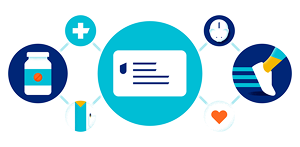If you experienced acne when you were a teen, you’ll remember how embarrassing it was. Especially when you get it on your face. You may have felt like, no matter what you did, you were on the verge of another breakout. But the good thing was, there was treatment for it.
While you might’ve thought you outgrew your acne, that’s not always the case. Some adults can get acne, too. And thankfully, there are special skin doctors or dermatologists that you can see to help treat it.
Let’s take a look at what causes adult acne, and what you can do about it.
Want to skip the waiting room? A HealthiestYou by Teladoc Health telehealth membership provides care for dermatology, general medicine and more. Learn more today.
What causes adult acne?
Acne develops when tiny openings in the skin (pores) become clogged, for example, with oil. Causes and common triggers for adult acne include:
- Hormones: Just like hormonal changes can be responsible for acne that occurs during puberty, they can also cause adult acne. This is particularly true for women who may experience fluctuating hormones tied to:
- Menopause
- Menstrual cycle
- Perimenopause
- Pregnancy
- Starting or stopping birth control pills.
About 20% to 40% of women who have adult acne get it first as an adult.
- Family history: You may have a genetic predisposition for acne, and be more likely to get adult acne, if a close blood relative has acne.
- Hair and skin products: Certain ingredients in hair and skin products may cause acne.
- Sports equipment and clothing: When sports equipment or clothing traps heat and sweat on your skin and rubs against your skin, it can cause acne.
- Diet: Some studies show that eating a low-glycemic diet (eating foods, like most fresh vegetables, that are less likely to make your blood sugar spike) may lead to fewer acne breakouts. But other studies have not found a link between these diets and acne.
- Side effect of medication: You might get acne when you take certain medications.
- Stress: Researchers have found a relationship between stress and acne flare-ups.
What are some over-the-counter treatments I can get for adult acne?
If you have mild adult acne, an over-the-counter (OTC) adult acne treatment might work for you. Mild acne means that you have small pimples and possibly blackheads and whiteheads.
To treat adult acne, look for topical products with the following active ingredients:
- Adapalene: This retinoid, which is a chemical derived from vitamin A (a lower strength than prescription retinoids), helps clear whiteheads, blackheads and pimples. (Whiteheads and blackheads form when excess oil and dead skin cells build up and plug the opening of a pore. Pimples form when excess oil, dead skin cells and bacteria get trapped inside a pore and cause redness and swelling.)
- Azelaic acid: In addition to fighting acne, azelaic acid (a lower strength than prescription azelaic acid) can help fade dark spots caused by acne. It’s a type of acid found in some grains, like rye and wheat.
- Benzoyl peroxide: Benzoyl peroxide reduces acne-causing bacteria on your skin and is especially effective at treating mild pimples.
- Salicylic acid: This ingredient unclogs pores and exfoliates skin to help resolve blackheads and whiteheads.
Try one type of OTC acne treatment product at a time, spreading a thin layer over each acne-prone area (not just on blemishes) and be patient. Use a product consistently for 6 to 8 weeks to see if there’s an improvement before trying a different one.
Additionally, there are LED devices approved for at-home use to treat pimples using visible light. Visible light is not effective against blackheads, whiteheads, acne cysts or nodules. (An acne cyst causes painful, pus-filled pimples to form deep under the skin, while a nodule is a severe type of acne that causes painful, hard lumps to form deep under the skin.) These devices are less powerful than the ones skin doctors may use.
Enter your zip code to find the virtual care options available in your area.
What are some prescription medications I can get for adult acne?
If OTC acne treatment isn’t working — for example, you have large, painful pimples or pimples that sit deep in your skin — it’s a good idea to see a skin doctor. (Another situation where you might want to consult a skin doctor? Acne that leaves a scar when it clears.)
You can book either an in-person or telehealth visit to help you determine how to get rid of adult acne. Topical prescription medications include:
- Retinoids: Prescription-strength retinoids include tazarotene and tretinoin.
- Topical antibiotic: Antibiotics can help reduce the inflammation that causes acne and acne-causing bacteria on the skin.
- Benzoyl peroxide: Your skin doctor may prescribe a medication or wash with benzoyl peroxide to be used in combination with a retinoid or antibiotic.
- Combination medicines: Some medications combine retinoids, an antibiotic and/or benzoyl peroxide.
- Azelaic acid: Prescription-strength azelaic acid is 20%.
- Clascoterone: This medication treats the hormonal changes that cause moderate to severe acne.
Oral prescription medications for adult acne may include:
- Antibiotics: You might get a prescription for medications like doxycycline or minocycline.
- Birth control pills: Certain combined oral contraceptives can be used to treat acne.
- Spironolactone: May be considered for women and adolescent girls if oral antibiotics aren’t helping.
- Isotretinoin: This medication is used for severe acne.
What are some medical procedures I can get for adult acne?
In addition to medications, there are some medical procedures that a skin doctor may use to treat adult acne.
- Steroid injection: For a severe breakout, a steroid shot can relieve swelling and pain.
- Chemical peel: A chemical peel helps remove dead skin cells that are clogging pores and excess oil.
- Laser or light treatments: Different types of laser and light treatments, such as infrared light, may be used to treat acne.
- Acne surgery: Also called acne extraction, acne surgery is used to physically remove acne breakouts.
What are some skin care routines I can use for adult acne?
Whether you’re using OTC or prescription medications, here are some tips for your skin-care routine to support treatment for your adult acne:
- Some of the better products for adult acne will say on their labels that they’re alcohol free and oil-free, noncomedogenic (i.e., it won’t clog your pores).
- Wash your face twice daily, when you wake up and when you go to bed, and after sweating. Use a gentle, nonabrasive cleaner that you apply with your fingertips.
- If your skin is dry, use a moisturizer.
- Avoid skin products that can irritate your skin, including astringents, toners and exfoliators.
- Wear a sunscreen with an SPF of 30 or higher on all skin not covered by clothing.
How do I connect with a dermatologist?
To kick off treatment for adult acne, you can set up a virtual visit with a dermatologist to talk about your treatment options.
A HealthiestYou by Teladoc Health telehealth membership, which costs $20 a month, can get you access to a dermatologist to talk about skin conditions.
In 2 business days or less, you can get a diagnosis and treatment for skin conditions including:
- Acne
- Eczema
- Rashes
- Psoriasis
- Rosacea
You don’t need an appointment — and you can communicate with a U.S. board-certified dermatologist through a secure online message center. Note that visit fees apply; they’re not included in the monthly fee.
For informational purposes only. This information is compiled by UnitedHealthcare, and/or one of its affiliates, and does not diagnose problems or recommend specific treatment. Services and medical technologies referenced herein may not be covered under your plan. Please consult directly with your primary care physician if you need medical advice.
Sources:
American Academy of Dermatology. “Acne: Signs and symptoms.” Retrieved from https://www.aad.org/public/diseases/acne/really-acne/symptoms#:~:text=This%20type%20of%20acne%20also,the%20black%20speck%20is%20dirt. Accessed October 17, 2024.
American Academy of Dermatology. “Acne: Tips for Managing.” Retrieved from https://www.aad.org/public/diseases/acne/skin-care/tips. Accessed October 7, 2024.
American Academy of Dermatology. “Acne: Who Gets and Causes.” Retrieved from https://www.aad.org/public/diseases/acne/causes/acne-causes. Accessed October 7, 2024.
American Academy of Dermatology. “Adult Acne.” Retrieved from https://www.aad.org/public/diseases/acne/really-acne/adult-acne. Accessed October 7, 2024.
American Academy of Dermatology. “Adult Acne Treatments Dermatologists Recommend.” Retrieved from https://www.aad.org/public/diseases/acne/diy/adult-acne-treatment. Accessed October 7, 2024.
American Academy of Dermatology. “Can the Right Diet Get Rid of Acne?” Retrieved from https://www.aad.org/public/diseases/acne/causes/diet. Accessed October 7, 2024.
American Academy of Dermatology. “Isotretinoin: The truth about side effects” Retrieved from https://www.aad.org/public/diseases/acne/derm-treat/isotretinoin/side-effects. Accessed September 12, 2023.
American Academy of Dermatology. “Is Sports Equipment Causing Your Acne?” Retrieved from https://www.aad.org/public/diseases/acne/causes/sports-equipment. Accessed October 7, 2024.
American Academy of Dermatology. “Lasers and Lights: How Well Do They Treat Acne?” Retrieved from https://www.aad.org/public/diseases/acne/derm-treat/lasers-lights. Accessed October 7, 2024.
American Academy of Dermatology. “Moisturizer: Why You May Need It If You Have Acne.” Retrieved from https://www.aad.org/public/diseases/acne/skin-care/moisturizer. Accessed October 7, 2024.
American Academy of Dermatology. “10 Skin Care Habits that Can Worsen Acne.” Retrieved from https://www.aad.org/public/diseases/acne/skin-care/habits-stop. Accessed October 7, 2024.
Cleveland Clinic. “Cystic acne.” Retrieved from https://my.clevelandclinic.org/health/diseases/21737-cystic-acne. Accessed December 10, 2024.
DermNet. “Clascoterone.” December 2022. Retrieved from https://dermnetnz.org/topics/clascoterone.
Mayo Clinic. “Acne.” July 20, 2024. Retrieved from https://www.mayoclinic.org/diseases-conditions/acne/diagnosis-treatment/drc-20368048.
National Library of Medicine. “Adapalene.” September 15, 2023. Retrieved from https://medlineplus.gov/druginfo/meds/a604001.html
WebMD. “Is Azelaic Acid Good for Your Skin?” March 1, 2024. Retrieved from https://www.webmd.com/skin-problems-and-treatments/what-to-know-about-azelaic-acid-skin.
Compliance code:
51841-X-1224








